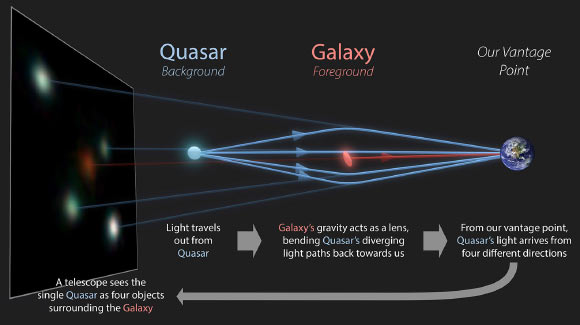Astronomers from the Gaia Gravitational Lenses group have identified 12 quadruply-imaged gravitationally-lensed quasars using machine-learning methods on the data from ESA’s Gaia mission and NASA’s Wide-field Infrared Survey Explorer (WISE).

Four of the newfound quadruply-imaged quasars are shown here; from top left and moving clockwise, the objects are: GraL J1537-3010 or Wolf’s Paw; GraL J0659+1629 or Gemini’s Crossbow; GraL J1651-0417 or Dragon’s Kite; GraL J2038-4008 or Microscope Lens. The fuzzy dot in the middle of the images is the lensing galaxy, the gravity of which is splitting the light from the quasar behind it in such a way to produce four quasar images. Image credit: Gaia Gravitational Lenses group.
The multiplication of quasar images and other objects in the cosmos occurs when the gravity of a foreground object, such as a galaxy, bends and magnifies the light of objects behind it.
Called gravitational lensing, this phenomenon has been seen many times before.
Sometimes quasars are lensed into two similar images; less commonly, they are lensed into four.
“Quads are better than the doubly imaged quasars for cosmology studies, such as measuring the distance to objects, because they can be exquisitely well modeled,” said Professor George Djorgovski, an astronomer in the Cahill Center for Astronomy and Astrophysics at Caltech.
“They are relatively clean laboratories for making these cosmological measurements.”

This diagram illustrates how quadruply imaged quasars, or quads for short, are produced on the sky. The light of a distant quasar, lying billions of light-years away, is bent by the gravity of a massive galaxy that happens to sit in front of it, as seen from our point of view on Earth. The bending of the light results in the illusion, a sort of gravity mirage, where the quasar appears to have split into four similar objects surrounding the foreground galaxy. Image credit: R. Hurt, IPAC & Caltech / Gaia Gravitational Lenses group.
In the new study, the researchers used WISE data from to find quasar candidates.
They then used the sharp resolution of Gaia to identify which of the WISE candidates were associated with possible quadruply imaged quasars.
They then applied machine-learning tools to pick out which candidates were most likely multiply imaged sources and not just different stars sitting close to each other in the sky.
Follow-up observations by Keck, Palomar, the New Technology Telescope, and Gemini-South confirmed which of the objects were indeed quadruply imaged quasars lying billions of light-years away.
“Machine learning was key to our study but it is not meant to replace human decisions,” sadi Dr. Alberto Krone-Martins, an astronomer in the Donald Bren School of Information and Computer Sciences at the University of California, Irvine, and the CENTRA at the Universidade de Lisboa.
“We continuously train and update the models in an ongoing learning loop, such that humans and the human expertise are an essential part of the loop.”
“The quads are gold mines for all sorts of questions,” said Dr. Daniel Stern, a research scientist at NASA’s Jet Propulsion Laboratory.
“They can help determine the expansion rate of the Universe, and help address other mysteries, such as dark matter and quasar ‘central engines’.”
“They are not just needles in a haystack but Swiss Army knives because they have so many uses.”
The study will be published in the Astrophysical Journal.
_____
D. Stern et al. 2021. Gaia GraL: Gaia DR2 Gravitational Lens Systems. VI. Spectroscopic Confirmation and Modeling of Quadruply-Imaged Lensed Quasars. ApJ, in press; arXiv: 2012.10051







